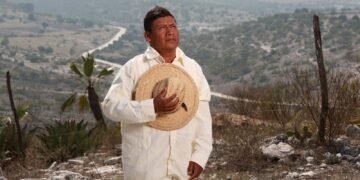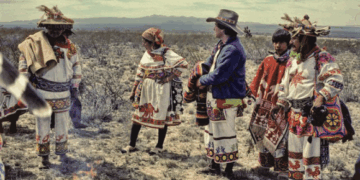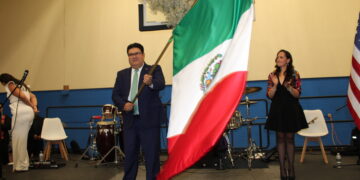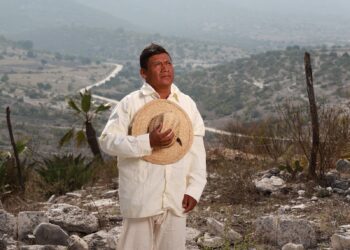The Rarámuri are an indigenous people, also known as Tarahumara, who live in northern Mexico, in the Sierra de Chihuahua region, at over 3,000 meters above sea level in the Copper Canyon. The name Rarámuri means “light-footed.” This name is due to their habit of running in the mountains to carry out their activities.
They inhabit the part of the Sierra Madre Occidental that crosses the states of Chihuahua, Durango, and Sonora. They share this territory with the Tepehuanes, Pimas, Guarojíos, and Mexican mestizos. Of the region’s indigenous groups, they are the most numerous, with a population of 50,000, occupying most of the mountain range, which is why this region is called the Sierra Tarahumara.
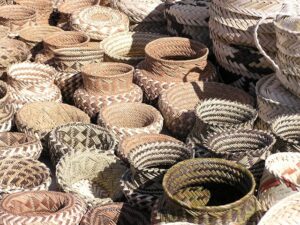
The Rarámuri language is part of the Uto-Aztecan language family, a language family that extends from Utah in the United States to Central America. Along with Concho and Guarojío, it is considered part of the Cahita-Opata-Tarahumara subgroup, related to the Pima-Tepehuan subgroup and the Cora-Huichol subgroup.
There are dialectal differences in the Tarahumara language that, while not profound, allow for a certain degree of intelligibility among all Tarahumara speakers.
From the perspective of this group, health reflects the quality of an individual’s relationships with other beings in the universe, as protection or harm from them depends on the interaction between humans and supernatural beings.
The Tarahumara believe that a human being is composed of a body and one or more souls. The body is made up of sapá (fleshy parts or muscles), ochí (bones), and lá (blood), animated by one or more souls.
The most serious illnesses are those that can cause the permanent loss of souls and are usually caused by a sorcerer or by the ingestion of the jícuri or bakánowi plants.

The Tarahumara live in ranches; their dwelling consists of a house, a barn, and a wooden corral. The houses are built with wood, adobe, quarry, or stone, depending on the material available in the region. The most common dwellings are made of pine logs arranged horizontally, one on top of the other, with a canoe-like or gabled roof; the logs are joined at the corners, and the cracks are filled with a mud mixture.
The origin of the Rarámuri and the Chabochis
According to the Rarámuri creation myth, Onorúame, the sun god, wanted to test the world he had created. He took some ears of corn, husked them, and formed the figure of a man from the kernels, blowing on it three times to give it life. Then, he formed the figure of a woman and blew on it four times, one more time to give her the strength she needed to give birth to her children. This is how the Rarámuri, the children of the corn, were created.
However, in the realm of darkness, another creation was taking place. The Devil, envious of the creation of the Tarahumara, wanted to create his own race of men. Since there was no corn in his kingdom, he took a handful of ashes and blew on it once to create the Chabochi, which is what the Rarámuri call the white man.
Tarahumara Soup
Ingredients
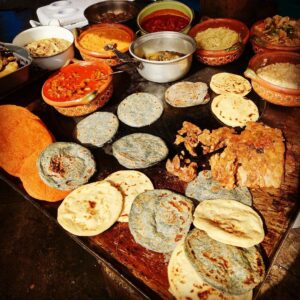
- 2 tablespoons oil
- 1 onion, chopped
- 2 cloves garlic, minced
- 1 cup tender corn kernels
- 1 1/2 liters chicken broth
- 1 sprig of epazote
- 1 cup chopped green beans
- 6 zucchini, chopped
- 500 grams squash blossoms, trimmed and chopped
- 4 sprigs chard, stemmed and chopped
- 4 sprigs spinach, leaves chopped
- 3 poblano peppers, roasted, peeled, deseeded, and diced
Preparation
- Heat the oil in a pot over medium heat. Add the onion and garlic and sauté until translucent. Add the broth and let it boil for 5 minutes.
- Add the green beans, zucchini, squash blossoms, chard, spinach, and chiles. Continue cooking over medium heat until all the vegetables are cooked.
Rarámuris / Tarahumaras
Los Rarámuris son un pueblo indígena, también conocidos como Tarahumaras, viven en el norte de México, en la región de la sierra de Chihuahua a más de 3,000 metros sobre el nivel del mar en las Barrancas del cobre. El nombre rarámuri significa “de los pies ligeros”. Esta denominación se debe a la costumbre que tienen de correr en las montañas para llevar a cabo sus actividades.
Habitan la parte de la Sierra Madre Occidental que atraviesa el estado de Chihuahua, Durango y Sonora. Comparten este territorio con los Tepehuanes, Pimas, Guarojíos y mexicanos mestizos. De los grupos originarios de la región es el más numeroso, con una población de 50,000 habitantes, ocupando así la mayor parte del territorio de la sierra, por lo que a esta región se le denomina sierra Tarahumara.

La lengua rarámuri forma parte de la familia yuto-azteca, familia de lenguas que se extiende desde Utah en los Estados Unidos hasta Centroamérica y está considerada junto con el Concho y el Guarojío dentro del subgrupo cahíta-ópata-tarahumara, emparentado con el subgrupo pima-tepehuano y el cora-huichol.
Existen diferencias dialectales en la lengua tarahumara que, sin llegar a ser muy profundas, provocan una cierta inteligibilidad entre todos los hablantes de tarahumara.
Desde la perspectiva de este grupo, la salud refleja la calidad de las relaciones del individuo con otros seres del universo, pues el que sean protegidos o dañados por ellos, depende de la interacción del hombre con los seres sobrenaturales.
Los tarahumaras consideran que el ser humano se compone de un cuerpo y de una o más almas. El cuerpo está constituido por sapá (partes carnosas o músculos), ochí (huesos) y lá (sangre), animados por una o más almas.
Las enfermedades más serias son aquellas que pueden causar la pérdida definitiva de las almas y que suelen ser provocadas por algún hechicero o por la ingestión de las plantas jícuri o bakánowi.

Los tarahumaras habitan en ranchos; su vivienda consiste en una casa-habitación, un granero y un corral de madera. Las casas se construyen con madera, adobe, cantera o piedra, dependiendo del material que haya en la región. Lo más común es encontrar viviendas hechas de troncos de pino dispuestos de manera horizontal, uno sobre otro, con techo de canoa o de vigas de dos aguas; los troncos son ensamblados en las esquinas y las rendijas son tapadas con una mezcla de lodo.
De cómo Dios creó a los Rarámuris y a los Chabochis
De acuerdo con el mito de creación de los Rarámuri, Onorúame, dios del sol, quiso poner a prueba el mundo que había creado. Tomó algunas mazorcas de maíz, las desgranó y formó con los granos una figura de hombre, a la cual sopló tres veces para darle vida. Después, formó una figura de mujer y sopló cuatro veces, un soplo más para darle la fuerza que necesitaba para dar a luz a sus hijos. Así es como fueron creados los Rarámuri, los hijos del maíz.
Sin embargo, en el reino de la oscuridad, otra creación se estaba gestando. El Diablo, al sentir envidia por la creación de los tarahumaras, quiso hacer a su propia raza de hombres. Como no había maíz en su reino, tomó un puñado de ceniza y sopló una sola vez para crear a los Chabochis, que es como los Rarámuri llaman al hombre blanco.
Sopa Tarahumara

Ingredientes
- 2 cucharadas de aceite
- 1 cebolla, picada
- 2 dientes de ajo, picados
- 1 taza de granos de elote tiernos
- 1 1⁄2 litros de caldo de pollo
- 1 rama de epazote
- 1 taza de ejotes picados
- 6 calabacitas, picadas
- 500 gramos de flor de calabaza, limpia y picada
- 4 ramas de acelgas, sin tallos y picadas
- 4 ramas de espinacas, sus hojas picadas
- 3 chiles poblanos, asados, pelados, desvenados y cortados en cuadritos
Preparación
- Calienta el aceite en una olla a fuego medio. Agrega la cebolla y el ajo, y sofríe hasta que se vean transparentes. Añade el caldo y deja que hierva durante 5 minutos.
- Incorpora los ejotes, calabacitas, flor de calabaza, acelgas, espinacas y chiles. Sigue cocinando a fuego medio hasta que todas las verduras se hayan cocido.


